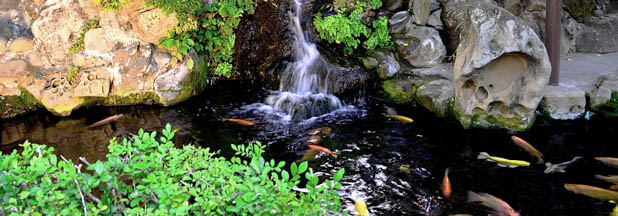First Steps for Koi Care at Home
First Steps for Koi Care at Home
These are the best techniques for introducing new koi into your pond, plus tips for continued at-home koi fish care from Kodama Koi Farm. Champion Japanese nishikigoi breeders follow these rules to insure healthy, long-lived koi and you can too!

Always Quarantine New Koi
Your pond is an ecosystem. It adapts and balances itself and becomes harmonious for the koi living within. Immunity to local bacteria, and each other, keeps everyone healthy and happy when your pond filtration is working effectively.
When you introduce new koi to your unique environment, even koi from a highly reputable breeder, means there is a risk of introducing harmful new bacteria or even viruses that can harm your pond.
You absolutely have to quarantine each new addition to your pond, and even take one step further if it has been over a year since any new arrivals.
The shipping process is exhausting and stressful. By allowing your new koi fish to have some private space to recuperate, you make sure it will be rested and healthy before having to socialize! The quarantine process is good for everyone!
Steps For Receiving Koi
You should have a small koi quarantine tank area set up. Use this area for new arrivals to test their health before introducing into main pond.
If you see any behaviors or symptoms of sickness, you can use the quarantine area to separate and keep a better eye on the fish in question. Catching a sickness early on means you can just treat one or two koi in that small tank, saving you on medication and work, and giving the sick koi a place to rest that is quiet.
Pre-Arrival of Koi
- Fill your tank with fresh dechlorinated water.
- Keep the temperature at 72 F or slightly above.
- A filtration system or aeration pump is necessary to avoid stale, stagnant water.
- Add salt to reach a 0.3% salination (3 pounds of salt per 100 gallons)
After You Receive Your Nishikigoi
- Observe your new arrival for two to three weeks. Look for unusual behaviors or any other symptoms.
- If you do not have a filtration system in place you must partially change the water every 2-3 days to keep it fresh and oxygenated. 25% percent of total water should suffice, just remember to add salt to return to 0.3% salinity.
- Check nitrate and ammonia levels DAILY. In a smaller tank, changes can escalate quickly and affect your koi’s well-being.
- Feed digestible food and be extra careful of overfeeding. Excess food can mess up nitrate levels and create a stagnant environment.
If you have not added any new koi fish in over a year there is an extra step that needs to be taken.
After the two weeks of quarantining the new koi, add one of your old fish to the tank and allow the two to spend about a week together. Keep an eye on both and watch for any signs of sickness. This extra step will help acclimate your new koi and just double check that the new koi isn't going to introduce anything to your pond.
Daily Koi Care Tips and Best Practices
Feeding
Nishikigoi are true omnivores and will eat almost anything that humans eat. They also still have the biological drive to eat whenever food is presented. They will continuously eat and can get very sick if allowed to do this.
The best choice is to feed them food designed to help them achieve maximum color and healthy growth. View the koi food we have for sale.
You can also read Kodama’s koi feeding tips for more info or read their full koi food guide. Feed them every three to four hours as much as they eat in 5-10 minutes. Keep a close eye to make sure no excess food is left, as it can indicate they aren’t feeling well. Excess food will also create bacteria growth, which will affect nitrogen levels, and make the pond unhealthy.
Water Quality and Maintenance
This is the most important aspect since your koi live and breathe the pond water. Excrement and excess food can cause algae and bacteria to flourish. This can choke the fish with low oxygen levels. Having a high quality pond filtration and air pump system is key to long life and healthy koi.
Also you must test the ammonia and nitrate levels often and they need to be as close to zero as possible. If you notice murky or cloudy water this is a sure sign that you need to tend to water quality, but even clear looking water can have dangerously high levels of ammonia or nitrates.
Learning to Observe Koi Health
As we said above, you must become familiar with your koi’s normal behaviors so you can quickly notice any changes that might indicate koi diseases & sickness.
Koi that swim sluggishly, especially when feeding, or koi that group together sluggishly are big signs. On the other hand, koi that swim excessively fast, or seem to wobble or zig zag, may have parasites and must be checked immediately
Be observant around the gills for any parasites or discoloration. If a koi’s breathing is affected, their health can decline very quickly.
You’re the keeper and best friend to these beautiful living jewels. They can give you a lifetime of peace, tranquility, and good fortune if they are well cared for.
Read more in this koi care article by Kodama Koi Farm and here’s to healthy, happy Nishikigoi!
Visit our website or contact us about pond pumps, complete pond kits, UV clarifiers, and other pond supplies at a great price!
|


